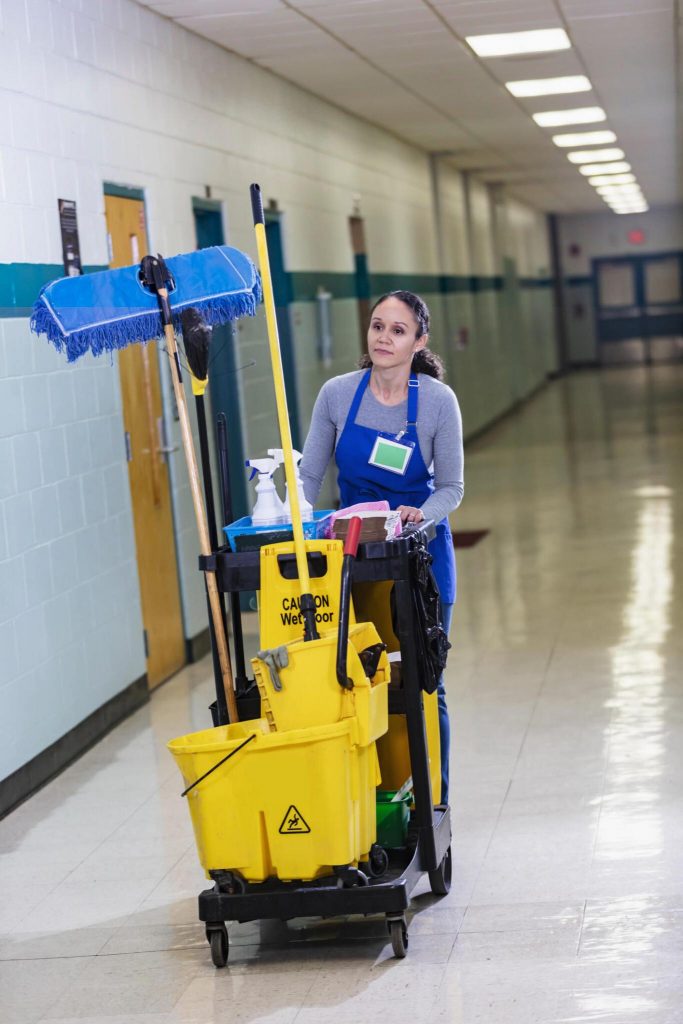Discover the ultimate school cleaning checklist to keep your educational facility spotless and hygienic. Ensure every nook and cranny is sparkling.
Hygiene is the practice of maintaining cleanliness to prevent the spread of diseases and promote overall health. In schools, promoting hygiene is crucial to safeguarding the well-being of students, teachers, and staff. A clean environment reduces the risk of infections and illnesses, leading to fewer absences and better academic performance. The concept of a school cleaning checklist is vital to ensuring a safe and hygienic environment by providing a systematic approach to cleaning and disinfection tasks. It helps schools uphold high standards of cleanliness, creating a conducive learning environment for everyone.
Why Is A School Cleaning Checklist Important?
A school cleaning checklist is vital for maintaining the health and safety of everyone on campus. It ensures thorough cleaning and disinfection, reducing the spread of germs and diseases. Key areas like classrooms, restrooms, cafeterias, and common areas require regular attention to prevent contamination. By detailing specific cleaning tasks, the checklist promotes accountability among cleaning personnel, ensuring tasks are completed promptly. It also helps identify potential breeding grounds for pests, such as food debris in cafeterias, enabling proactive measures to address them.
Benefits Of A Clean School Environment
A clean school environment fosters better health, reduces absenteeism, and enhances academic performance. It promotes a positive atmosphere for learning and teaching, leading to improved student and staff well-being. Here are the benefits of having a clean school environment, including:
Healthier Environment
A clean school environment reduces the spread of germs and illnesses, resulting in fewer sick days for students and staff. Proper cleaning and disinfecting of surfaces, especially high-touch areas like doorknobs and desks, can help prevent the spread of viruses and bacteria. This is particularly important in shared spaces like classrooms, gyms, and cafeterias, where students are in close contact with each other.
Improved Academic Performance
A clean and organized environment plays a vital role in enhancing students’ focus, concentration, and academic performance. A clutter-free space reduces distractions, allowing students to concentrate better on their studies. Moreover, cleanliness promotes a sense of well-being and comfort, which positively impacts students’ mental state and motivation to learn. By creating a conducive learning environment, schools can foster an atmosphere where students feel supported and empowered to excel academically.
Enhanced Safety
A clean environment ensures clear walkways, properly functioning equipment, and safe learning spaces. For example, regular cleaning of spills reduces slip and fall hazards, while proper maintenance of playground equipment minimizes the risk of injuries. Cleanliness directly impacts safety measures such as fire prevention, emergency evacuation procedures, and the overall well-being of students and staff, fostering a secure educational environment.
Equipment Longevity
Cleanliness is essential for prolonging the longevity of equipment used in schools. Regular cleaning prevents the accumulation of dust, dirt, and debris, which can lead to equipment malfunctions or deterioration over time. Moreover, cleaning tools such as microfiber cloths, brushes, and gentle cleaning solutions are employed to remove contaminants without causing damage to sensitive equipment surfaces. By implementing proper cleaning strategies, schools can ensure that their equipment remains in optimal condition, reducing the need for costly repairs or replacements.
Positive School Image
A clean school environment is crucial for shaping the institution’s overall image and reputation. A well-maintained campus reflects positively on the school’s values, professionalism, and commitment to excellence. It creates a welcoming atmosphere for students, staff, and visitors, fostering a sense of pride and belonging. Additionally, a clean school environment promotes positive perceptions among parents, prospective students, and the community, reinforcing the school’s reputation as a safe, caring, and high-quality educational institution.
Daily School Cleaning Tasks
Daily school cleaning tasks encompass a range of activities aimed at maintaining cleanliness and hygiene throughout the campus. These tasks ensure that classrooms, restrooms, common areas, and other facilities remain clean, safe, and conducive to learning.
Floors
Effective floor cleaning methods include regular sweeping, mopping with appropriate cleaning solutions, and spot cleaning for spills. In order to deep clean floor tiles, use a mild detergent and warm water to clean, avoiding harsh chemicals that can damage the surface. Common types of floors in schools include vinyl, hardwood, and ceramic tiles, each requiring specific cleaning techniques to maintain their appearance and durability.
Windows
To properly clean windows, use a solution of water and vinegar or a commercial glass cleaner along with a squeegee or microfiber cloth for streak-free results. Clean windows play a crucial role in maintaining a bright and welcoming atmosphere in classrooms by allowing natural light to filter in. Natural light not only creates a pleasant environment but also enhances students’ focus and mood, promoting a conducive learning atmosphere.
High-Traffic Spaces
Cleaning high-traffic spaces like hallways and common areas is crucial for maintaining a healthy school environment. Implementing efficient cleaning strategies such as regular sweeping, vacuuming, and disinfecting surfaces helps ensure thorough sanitation. As cleanliness plays a vital role in preventing the spread of germs and infections among students and staff. By prioritizing the cleanliness of these areas, schools can create a safer and more hygienic environment conducive to learning and well-being.
Trash
Effectively managing and disposing of trash is essential for maintaining a clean and hygienic school environment. Implementing proper waste management practices ensures that trash is collected and disposed of regularly, minimizing the risk of odors and pests. Additionally, recycling and reducing waste generation contribute to environmental sustainability by conserving resources and reducing landfill waste. By promoting responsible waste management, schools not only uphold cleanliness but also teach students valuable lessons about environmental stewardship and sustainability.
Doors
Regularly cleaning door handles and knobs is vital to prevent the spread of germs among students and staff. Use disinfectant wipes or sprays to clean door hardware daily, ensuring thorough disinfection. Clean doors not only maintain a hygienic environment but also leave a positive first impression of the school, showcasing its commitment to cleanliness and safety. By prioritizing the cleanliness of door hardware, schools can create a welcoming and germ-free environment for everyone.
Tables
Regularly cleaning tables in classrooms, libraries, and cafeteria settings is crucial for preventing the spread of illness among students and staff. Use a disinfectant solution to wipe down tables after each use, focusing on high-touch areas like tabletops and edges. Clean tables contribute to a healthier learning environment, reducing the risk of infections and promoting student well-being. By prioritizing table cleanliness, schools can create a safer and more conducive setting for academic success.
High-Touch Surfaces
Common high-touch surfaces in schools include door handles, light switches, desks, chairs, computer keyboards, and faucet handles. To effectively clean and disinfect these surfaces, use EPA-approved disinfectants and follow the manufacturer’s instructions for proper application. Regular cleaning of high-touch surfaces reduces the risk of illness transmission and promotes a healthier school environment.
Cafeteria
It is vital to maintain cleanliness in the school cafeteria to ensure food safety and hygiene. Specific cleaning protocols for cafeteria surfaces, equipment, and dining areas include regular sanitization of countertops, tables, and serving utensils. Cleanliness in the cafeteria promotes a positive dining experience for students and staff by providing a safe and pleasant environment for meals. It also demonstrates the school’s commitment to maintaining high standards of cleanliness and hygiene throughout the campus.
Weekly School Cleaning Tasks
Maintaining cleanliness in school office environments is vital for fostering a conducive work atmosphere. Clean surroundings promote productivity and boost employee morale by creating a comfortable and pleasant workspace. Employees feel motivated and inspired to perform their best when working in a clean and organized environment, ultimately contributing to the overall success of the school.
Glass Surfaces
Streak-free and spotless glass surfaces are essential for maintaining a professional appearance in any setting. To achieve this, use a mixture of water and vinegar or a commercial glass cleaner along with a microfiber cloth or squeegee for optimal results. When handling glass cleaning chemicals, ensure proper ventilation and wear protective gloves and eyewear to prevent irritation or injury. Prioritizing the cleanliness of glass surfaces enhances the overall aesthetic and professionalism of the environment.
Dusting
Regular dusting is essential for maintaining a clean and allergen-free workspace. Using microfiber cloths or dusters ensures efficient dust removal without spreading particles. Moreover, areas prone to dust accumulation include computer monitors, shelves, and other surfaces. Prioritizing regular dusting helps create a healthier environment by reducing allergens and improving air quality, ultimately contributing to a more comfortable and productive workspace.
Window Cleaning
Weekly window cleaning in schools is essential for maintaining visibility and cleanliness. Clean windows allow natural light to enter, creating a brighter and more inviting atmosphere for students and staff. To achieve this, use a solution of water and mild detergent with a squeegee or microfiber cloth to effectively remove dirt and grime. Hence, regular window cleaning not only enhances the appearance of the school but also contributes to a healthier and more comfortable learning environment.
Disinfecting High-Touch Surfaces
High-touch surfaces in schools include door handles, light switches, desks, and faucets—areas frequently touched by students and staff. Sanitizing these surfaces is crucial for preventing the spread of germs and reducing the risk of illness. Utilize disinfectant wipes or sprays to effectively clean and sanitize high-touch surfaces. Regular disinfection not only promotes a healthier school environment but also helps maintain the well-being of students and staff, contributing to overall safety and productivity.
Monthly School Cleaning Tasks
Maintaining a clean and safe environment in schools is paramount for the health and productivity of students, teachers, and staff. A well-organized monthly cleaning routine ensures that all areas are thoroughly cleaned and sanitized, reducing the risk of illness and creating a conducive learning environment. By prioritizing cleanliness, schools can promote student well-being and enhance overall academic performance.
Deep Cleaning Of Classrooms
Deep cleaning of classrooms involves thorough tasks such as dusting, sanitizing desks and chairs, wiping down whiteboards, and disinfecting high-touch surfaces. This comprehensive approach reduces the spread of germs and allergens, creating a healthier environment for students and teachers. By ensuring classrooms are clean and sanitized, the risk of illness transmission is minimized, fostering a conducive space for learning and academic success.
Common Areas
Cleaning common areas such as hallways, corridors, and cafeterias involves tasks like sweeping, mopping, and disinfecting surfaces. Moreover, the common tools used include brooms, mops, and disinfectant sprays. Additionally, clean common areas contribute to a welcoming atmosphere and foster a sense of community within the school by providing a tidy and safe environment for students, teachers, and staff to interact and move around comfortably, ultimately enhancing the overall school experience.
Restrooms
Restroom cleaning involves essential tasks like disinfecting toilets, sinks, and mirrors, as well as restocking supplies and controlling odors. Maintaining hygienic restrooms is crucial to promoting good health practices and enhancing the overall school experience. Thus, clean and well-maintained restrooms not only contribute to a healthier environment but also ensure the comfort and satisfaction of students, staff, and visitors, ultimately improving the quality of their time spent at the school.
Outdoor Areas
Cleaning and maintaining outdoor areas like playgrounds, sports fields, and parking lots involves tasks such as removing debris, trash cans, and sweeping surfaces. It’s essential to ensure these areas are clean and well-maintained to provide safe and enjoyable spaces for students to engage in recreational activities. Because, regular upkeep not only enhances the aesthetics of outdoor spaces but also minimizes hazards, promoting a positive and conducive environment for outdoor play and leisure.
Administrative Areas
Administrative areas require special attention due to their frequent use. A systematic approach to cleaning should involve dusting desks, chairs, and filing cabinets, as well as wiping down surfaces and ensuring trash bins are emptied regularly. Clean walls contribute to a professional atmosphere. Additionally, maintaining confidentiality when handling documents and personal belongings is crucial to upholding privacy and trust within the office environment.
Effective Strategies For Maintaining School Cleanliness
Effective strategies for maintaining school cleanliness involve implementing regular cleaning schedules and promoting proper hygiene practices among students and staff. It also ensures adequate supplies and equipment are available for cleaning tasks.
Establish Clear Cleaning Protocols
Having clear cleaning protocols for various school areas is vital for cleanliness. Daily tasks include sweeping floors and wiping surfaces, while weekly tasks may include mopping floors and disinfecting high-touch areas. Monthly tasks that can be included include sanitizing restrooms and restocking supplies.
Implement A Regular Cleaning Schedule
Implementing a regular cleaning schedule is essential to maintaining cleanliness throughout the school. This schedule should include daily, weekly, and monthly tasks, as well as specific responsibilities for individual staff members. Additionally, the schedule should be visible and easily accessible to all school staff.
Provide Adequate Cleaning Supplies
It is essential to provide adequate cleaning supplies to maintain cleanliness in the school. Custodial staff should have easy access to disinfectants, trash bags, and hand sanitizers, while teachers and students can contribute by keeping their areas tidy. It is also important to stock essential supplies such as paper towels and glass surface cleaners.
Promote Personal Responsibility
Encourage students and staff to take ownership of their surroundings, which fosters a sense of pride and accountability. Providing tools such as a classroom cleaning checklist can help establish routines for regular cleaning tasks. It is also crucial to emphasize the importance of cleanliness through education and leading by example reinforces the value of personal responsibility in keeping the school environment clean and inviting for everyone.
Designate Cleaning Duties
Designating specific cleaning duties to custodial staff and implementing a rotating schedule offers several benefits. It ensures that all areas of the school receive consistent attention and maintenance. Distributing tasks fairly among the custodial team promotes teamwork and accountability. Consider factors such as individual strengths and preferences when assigning duties to maximize efficiency and satisfaction.
Monitor And Inspect
Regularly monitoring and inspecting the cleanliness of the school premises is essential for maintaining high standards of hygiene. Identify cleanliness issues, including conducting walkthroughs, inspecting high-traffic areas, and soliciting feedback from staff and students. This allows for any problem areas to be addressed promptly and ensures that the custodial staff is aware of what needs to be prioritized in their cleaning duties.
Promote Hygiene Practices
Cleanliness and good hygiene habits, such as handwashing and covering coughs and sneezes, go hand in hand. Educating students and staff on the importance of these behaviors fosters a healthier environment. Also, encouraging students to keep their personal spaces, such as lockers and desks, clean can prevent the spread of germs and bacteria.
Get A Professional Solution For School Cleanliness!
With Green Clean Janitorial, you can trust that your school will receive top-notch, professional cleaning services. Our team is equipped to handle all aspects of school cleanliness, from daily janitorial tasks to deep cleaning and floor maintenance. We use eco-friendly products and techniques to ensure a safe and healthy environment for students and staff.
Don’t let a dirty school hinder the learning process. Contact us today to schedule a consultation and see how we can help keep your school clean and healthy!
FAQs
A school cleaning checklist is a detailed document outlining all the cleaning tasks required to maintain a clean and hygienic environment in a school facility. It serves as a guide for janitorial staff or cleaning crews to ensure thorough and consistent cleaning practices.
A school cleaning checklist is important for maintaining the health and safety of students, teachers, and staff. It helps ensure that all areas of the school, including classrooms, restrooms, cafeterias, and common areas, are cleaned regularly and effectively, reducing the spread of germs and preventing the buildup of dirt and debris.
A comprehensive school cleaning checklist should include tasks such as dusting, vacuuming, mopping, sanitizing surfaces, cleaning windows, emptying trash bins, disinfecting restrooms, and restocking supplies. It should cover all areas of the school, both indoors and outdoors, and be tailored to the specific needs of the facility.
A school cleaning checklist should be used on a regular basis, ideally daily or weekly, depending on the frequency of use and foot traffic in different areas of the school. Some tasks, such as restroom cleaning and trash removal, may need to be done multiple times a day, while others, like floor waxing or deep cleaning, may be done less frequently on a monthly or quarterly basis.




